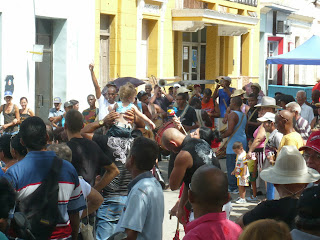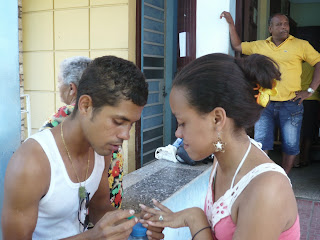From the US point of view the Cuban Revolution started with
"Castro" and came out of nowhere. From the Cuban perspective, it was the culmination of an
almost 100 year struggle to free the island from foreign domination.
On October 10,
in 1868 Carlos Manuel de Cespedes freed "his" enslaved people
and invited them to join him in freeing Cuba from Spanish rule. The end of slavery became one of the
central goals of the independence struggle. When the Spanish offered a compromise which included a
limited independence conditioned on no change in the social and economic
conditions, this was rejected by the Cuban independence fighters.
Jose Marti was the intellectual center
of the independence movement; his writings are still closely studied and he is
revered in Cuba.
He died in battle
in 1895.
His last written words
were "Be just." He emphasized the participation of all races as
essential to true independence.
Antonio Maceo was the liberation struggle's greatest general. He was a
descendent of the African diaspora. His grasp of the issues involved with
national liberation, well as of political strategy, was profound; he was
instrumental in refusing the Spanish compromise; this monument symbolizes that
refusal. He was killed in 1896.
There are monuments to both throughout Cuba.


At this point Cuba was at the point of freeing itself from
Spain. Then the US stepped in,
taking over Cuba from Spain at the Treaty of Paris (much as we took over the
colonial power role from the French in Vietnam 50-something years later). No Cuban representative was permitted
by the US at this conference, and the treaty set no time limit for the US
occupation of Cuba. The Cuban struggle for independence from the US continued
in various forms for the next 61 years and finally was victorious in January
1959. The beginning of this last
successful struggle was the organizing in the cities, countryside, schools, and
political arena and the first shots were fired at Moncada Military Barracks in
Santiago July 26 1953. After years of organizing against tyranny and for better
government, 158 men and 2 women
led by Fidel Castro and Abel Santamaria attacked the Moncada army barracks in
Santiago de Cuba.



Some were killed
in battle, many were captured, tortured and killed. As a military operation it
failed; there were logistical errors and mishaps as well as an overwhelming
disparity in numbers and arms.
But
Moncada wasn't only a military action, it was a political action and an
organizing action and it was not a failure in those terms.
As we all know, 5 ½ years later the
revolution triumphed.
At the most recent celebration of the revolution's
beginning, the heads of state of many
Latin American and
Caribbean nations went to Santiago de Cuba and spoke in front of the
Moncada, formerly army barracks, now a museum and school complex. Presidents and prime ministers thought
this was an important occasion: Evo Morales of Bolivia, Daniel Ortega of
Nicaragua, Jose Mujica of Uruguay, Nicolas Maduro of Venezuela, Roosevelt
Skerrit of Dominica, Winston Baldwin-Spencer of Antigua and Barbuda, Kenny
Davis Anthony of Santa Lucia, Ralph Gonsalves of St. Vincent &
Grenadines. A lot was said
but common themes were, "
Cuba gave dignity to the people of Latin America" and "Cuba taught us
not to be afraid."
OK, so an island nation of a few million people threw off a
repressive government. What is it
about this change that has made Cuba an inspiration, a guiding light in the
world, from one point of view and from the opposite point of view a country which must be forbidden to
trade, and which you as a US citizen are forbidden to go see? The US had always assumed that it had
the absolute right to decide everything that happened in the Western
Hemisphere. This didn't leave much
independence or dignity for those whose lives and countries we were
controlling. Attempts at defiance
or autonomy were quickly punished, by direct military force if required. Cuba has not only held out, it has
promoted the international nature of revolution. Cuban volunteers in Angola fought the forces of apartheid
South Africa and defeated them.
Cuban doctors are spread throughout Latin America and the
Caribbean. Evo Morales said,
"The Cuban revolution is the mother of all the revolutions of America and
of the world," and remembered that when he planned land reform which he
feared would cause US retaliation, Fidel had said, "Evo, you are not
alone." The other big
inspiration, or problem depending on your perspective, is that Cuba has tried
to find a working alternative to corporate capitalism and the relationships
among people that it produces.
There is no laboratory for social and economic changes, and they are not
quick or fool-proof or easy. The
experiments have to happen among living people and some things go right and others
don't. Enough has gone right to make the Cuban example very threatening to
those who want corporate capitalism to occupy the whole world. Cuba has tried to be a revolution of,
by and for the
"humildes" - the ordinary people, (I'm quoting
Raul Castro here, who also spoke.)
It has tried to be a revolution of dignity and self-worth, and respect
for diversity, of basic equality, of
the weak not fearing that they will be crushed by the strong. (quoting Jose Mujica, president of
Uruguay) This alternative way is
either profoundly inspiring or really scary, depending on your outlook. I was very proud to be present with
Pastors for Peace at the celebration of the 60th anniversary of the start of
the Cuban Revolution.
There are common themes which run through this history and
cause the Cubans to see it as a continuing narrative:
An absolute refusal of foreign domination,
A commitment to the idea that national liberation is
intrinsically linked to the idea of racial liberation,
A dedication by people across class, racial and gender lines
to the struggle for sovereignty, to the point of giving their lives,
and the fact that revolution always begins in Oriente - in
the eastern province for which Santiago is the main city. It's a revolutionary city and in addition
to the official signs and posters about the 26th, many people did a bit of
homemade decoration. One of the
city's mottos is "Here no one surrenders." - that's what's written on
the Juan Almeida image.




 It has been alleged, and some studies show, that highly competitive societies promote sociopathic behavior. Since the absence of mercy and morals offers advantages in achieving business success, this becomes adaptive behavior. Perhaps the Cuban achievement is not to have formed the communist new man but to have resisted the creation of the capitalist neoliberal new man and to have allowed people's natural humanity to remain intact.
It has been alleged, and some studies show, that highly competitive societies promote sociopathic behavior. Since the absence of mercy and morals offers advantages in achieving business success, this becomes adaptive behavior. Perhaps the Cuban achievement is not to have formed the communist new man but to have resisted the creation of the capitalist neoliberal new man and to have allowed people's natural humanity to remain intact.










































